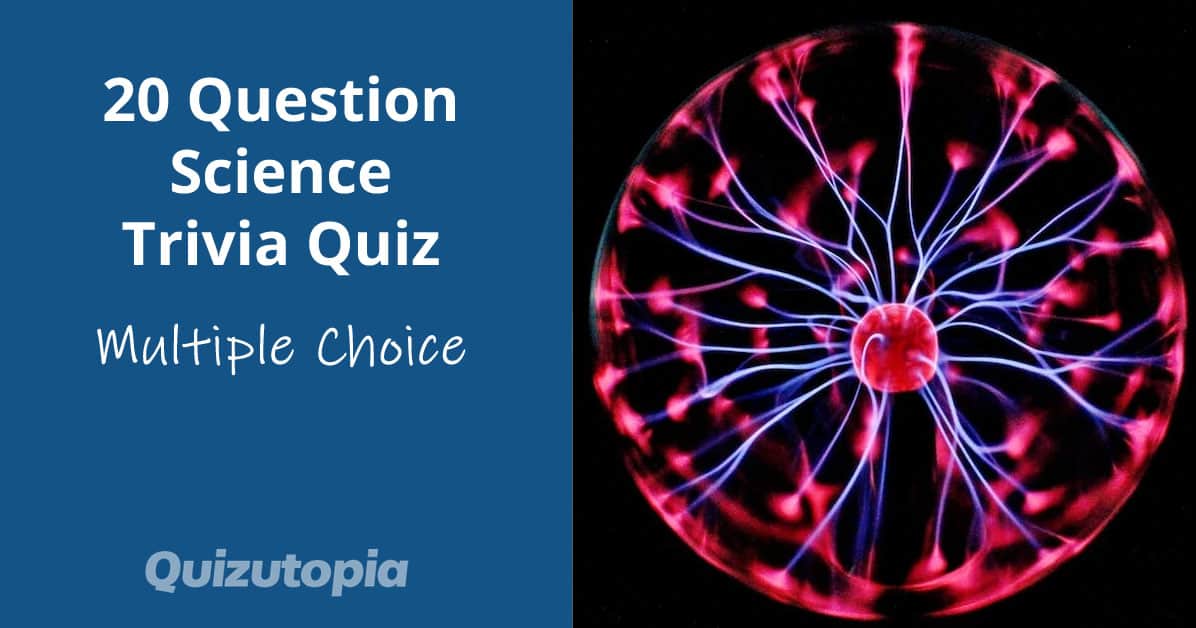Are you a science whiz who loves a challenge? Do you relish the opportunity to show off your knowledge? Then you’ve come to the right place! Our 20 question science trivia quiz is sure to test your scientific know-how. We’ve compiled a selection of questions from a range of scientific fields, including chemistry, biology, physics, and more.
Our questions cover a range of difficulty levels, so you’ll be sure to find something to suit your skillset. From the periodic table of elements to the laws of motion, you’ll be sure to be tested on the core scientific principles.
So put your thinking cap on, and get ready to flex your scientific muscles! We’re sure you’ll have a blast testing your knowledge with our 20 question science trivia quiz. Good luck!

Subscribe to our mailing list to receive FREE exclusive quizzes and offers!
- The chemical symbol of the element Phosphorus is?
- Cf
- Kr
- P
- Eu
The correct answer is “P”.
The chemical symbol of Phosphorus is P, as it is the first letter of the element’s name in the periodic table. - The chemical symbol of the element Hafnium is?
- K
- Hf
- Pm
- Sm
The correct answer is “Hf”.
Hafnium is a transition metal element on the periodic table, and its chemical symbol is Hf, derived from its Latin name, Hafnia. - The chemical symbol of the element Scandium is?
- N
- Sc
- Fl
- He
The correct answer is “Sc”.
Scandium is a chemical element with the atomic number 21, and its chemical symbol is Sc. - Who discovered the laws of thermodynamics?
- James Clerk Maxwell
- Robert Boyle
- Isaac Newton
- Lord Kelvin
The correct answer is Lord Kelvin.
Lord Kelvin (William Thomson) was a 19th century British physicist who developed the first and second laws of thermodynamics. He is credited with recognizing the importance of energy conservation and introducing the concept of absolute temperature.
- Who developed the theory of evolution through natural selection?
- Albert Einstein
- Isaac Newton
- Charles Darwin
- Galileo Galilei
The correct answer is Charles Darwin.
Charles Darwin is widely credited with developing the theory of evolution through natural selection. His groundbreaking work, which was published in 1859, outlined the process of evolution and how species adapt to their environment over time. - Which one of the following is a “noble” gas?
- Isobutane (C4H10)
- Chlorine (Cl2)
- Radon (Rn)
- Nitrous oxide (N2O)
The correct answer is Radon (Rn).
Radon (Rn) is a radioactive, colorless, odorless, tasteless noble gas which is the heaviest known gas and is naturally occurring in the environment. - Who discovered the Big Bang theory?
- Albert Einstein
- Stephen Hawking
- Georges Lemaître
- Charles Darwin
The correct answer is Georges Lemaître.
Georges Lemaître was a Belgian priest and astrophysicist who proposed the theory of the universe beginning from a single primordial atom, now known as the Big Bang theory. - The chemical symbol of the element Lead is?
- Pb
- Ac
- Zn
- Rf
The correct answer is “Pb”.
Lead is a chemical element with the atomic number 82, which is represented by the symbol Pb. - Which one of the following is a “noble” gas?
- Hydrogen (H)
- Fluorine (F2)
- Ozone (O3)
- Helium (He)
The correct answer is Helium (He).
Helium is a noble gas because it is an element on the periodic table that does not react with other elements and is stable in its natural state. - Who discovered the process of photosynthesis?
- Thomas Edison
- Robert Boyle
- Jan Ingenhousz
- Jan van Helmont
The correct answer is Jan Ingenhousz.
Jan Ingenhousz was a Dutch biologist who is credited with discovering the process of photosynthesis in 1779. He determined that sunlight was essential for plants to produce oxygen, and that this process occurred in the leaves.
- Who discovered the laws of planetary motion?
- Charles Darwin
- Galileo Galilei
- Isaac Newton
- Johannes Kepler
The correct answer is Johannes Kepler.
Johannes Kepler was a German astronomer and mathematician who formulated three laws of planetary motion based on his observations of the planets in the early 17th century. - Who discovered the smallpox vaccine?
- Robert Koch
- Edward Jenner
- Louis Pasteur
- Marie Curie
The correct answer is Edward Jenner.
Edward Jenner was an English scientist who is credited with discovering the smallpox vaccine in 1796, which marked a major milestone in the fight against infectious disease. - The chemical symbol of the element Francium is?
- Rg
- Fr
- Rh
- Rn
The correct answer is “Fr”.
Francium is the last element in the periodic table and is symbolized by Fr, which is derived from its Latin name, Francum. - The chemical symbol of the element Calcium is?
- Ds
- Ca
- Ta
- Mg
The correct answer is “Ca”.
Calcium is a chemical element which is represented by the symbol Ca on the periodic table. It is a soft, silvery-white, alkaline earth metal.
- The chemical symbol of the element Silver is?
- Mc
- Ag
- Ir
- Cu
The correct answer is “Ag”.
Silver is a chemical element represented by the symbol Ag, which stands for the Latin word ‘argentum’, meaning ‘silver’. - Who is known as the father of modern science?
- Isaac Newton
- Albert Einstein
- Galileo Galilei
- Werner Heisenberg
The correct answer is Galileo Galilei.
Galileo Galilei is credited with ushering in the scientific revolution of the 17th century and is widely considered to be the “Father of Modern Science” for his contributions to the fields of astronomy, physics, and mathematics. - Who is known for his theory of relativity?
- Charles Darwin
- Albert Einstein
- Galileo Galilei
- Isaac Newton
The correct answer is Albert Einstein.
Albert Einstein is a famous physicist who is best known for his groundbreaking theory of relativity, which revolutionized our understanding of the physical universe. - The chemical symbol of the element Darmstadtium is?
- Lu
- Hg
- Rh
- Ds
The correct answer is “Ds”.
Darmstadtium is a synthetic element that has not been found in nature and is represented by the chemical symbol Ds. - Which one of the following is a “noble” gas?
- Carbon monoxide (CO)
- Krypton (Kr)
- Propane (C3H8)
- Carbon dioxide (CO2)
The correct answer is Krypton (Kr).
Krypton (Kr) is a noble gas because it is an unreactive, colorless, odorless gas which belongs to the group of elements known as the noble gases.
- The chemical symbol of the element Helium is?
- Po
- Mn
- Cs
- He
The correct answer is “He”.
Helium is a chemical element represented by the symbol He on the periodic table. It is a colorless, odorless, tasteless noble gas.









